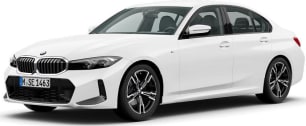It isn’t just parcels and packages that benefit from all the engineering advances made in the new-gen Transit Custom.
Big doors open to a new, lower and larger cabin. With the front wheels pushed forward, it’s flatter, with more space for three-abreast seating. And, now, the driver enjoys better cross-cabin access right to the opposite door with fewer obstacles.
To aid entry and egress due to its flat base, the E-Transit Custom scores a “squircle” (squarish) steering wheel. It’s one of the few visual distinctions in an otherwise fairly mundane, though well-made, interior. Material quality is of the hardy but pleasant variety.
Our test van was the optional Sport model as-yet not confirmed for the EV (though it’s coming for the diesel), with darker hues, upholstery stripes and a few more luxury features.
Australian-bound E-Transit Customs will be closer to the European Trend spec, which we factored in strongly when assessing the electrified newcomer.
Both grades sampled included Ford’s optional ‘Mobile Office’ that will be made available in Australia. Among other things, it provides a three-position wheel, from the regular position to roughly 45- and 90-degree angles.
The thinking here is for drivers to respectively either rest a laptop or have an in-situ table – complete with a squircle-shaped tray – tilt all the way forward for meal times. A lockout device prevents vehicle operation in anything but the home position.
Handy, though note that two of the three vans we drove with this feature had a rattly wheel in the normal driving position. Ford promises a fix for production is coming.
Other Mobile Office additions include various mounting points for accessories.
The driving position is 4WD-high, with the vast windscreen and very deep side windows providing panoramic views. Because of the rear bulkhead behind the seats, a camera-fied rear-vision mirror, along with the sizeable exterior mirrors, provide sufficient side/rear vision.
The driver’s seat is supportive and comfy if not that shapely, and it seems more fully padded than the flimsy cushions of the (narrower) centre and passenger seats.
The latter both hinge forward to reveal a massive storage cavity (ideal for charging cables) as well as the load-through hatch as per the previous-gen Transit where fitted.
Speaking of storage, Ford’s engineers have repositioned the passenger front airbag from its traditional dashtop home to above the windscreen header, liberating a second glove box fit for housing laptops.
The dashboard’s 13-inch touchscreen is perfectly sized and driver-angled. It uses Ford’s excellent SYNC 4 multimedia system, is powered by a 5G modem for OTA software updates for around 30 modules, and is functional, fast and intuitive. It also comes with Alexa voice commands.
Ample ventilation, big grab handles, massive door pockets for bottles, additional storage areas including behind the configurable digital instrumentation pod, several cupholders, USB-A and -C outlets near shelving areas for minimal cable entanglements, plenty of LED light sources and an armrest/tray, highlight Ford’s many decades of experience building mid-sized vans.
On the launch drive's smooth German roads, wind and road noise intrusion were impressively subdued for a van (especially so given the quiet e-motor operation compared to the clatter of a diesel), though the large frontal area means at speed you won’t mistake this for a luxury EV.
Still, being roomy yet cosy, practical yet thoughtfully presented and solidly built without feeling cheap, the E-Transit Custom's cabin is right on the money – a secure and inviting workhorse first and foremost.
Keep in mind, too, that the cargo area will likely include Ford’s 'Load Area Protection Kit', bringing a moulded load floor liner and protection for the sides and rear doors. Because, this is a workhorse, after all.

